UT McClung Museum Receives Large Gift of Rare Maps
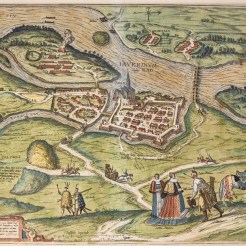
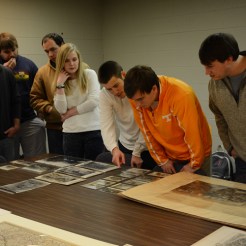


Every month the AAG compiles a list of newly-published books in geography and related areas. Some are selected for review in the AAG Review of Books.
Publishers are welcome to send new volumes to the Editor-in-Chief (Kent Mathewson, Editor-in-Chief, AAG Review of Books, Department of Geography and Anthropology, Louisiana State University, Baton Rouge, LA 70803).
Anyone interested in reviewing these or other titles should also contact the Editor-in-Chief.
July 2015
This new annual award recognizes outstanding achievement in teaching undergraduate geography including the use of innovative teaching methods. The award is generously funded by John Wiley & Sons in memory of their long-standing collaboration with the late Harm de Blij on his seminal geography textbooks.
Eligibility: Individual faculty or instructors who are current members of the AAG and for whom teaching geography is a primary responsibility are eligible to receive the award.
Nominations: To make nominations for the AAG Harm J. de Blij Award, you must be a current member of the AAG. Please include the complete name, affiliation and address of the nominee(s), their curriculum vitae, and a concise (500 words maximum) yet specific description of the accomplishments that warrant their selection. Digital submissions are encouraged. Send nominations to grantsawards [at] aag [dot] org with AAG Harm J. de Blij Award as the subject line. Alternatively, hard copy nominations can be mailed to:
ATTN: AAG Harm J. de Blij Award
Association of American Geographers
1710 16th Street NW
Washington, DC 20009-3198.
For more detail about this new award, please visit www.aag.org/de-Blij.
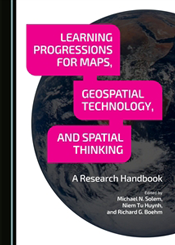 AAG and Cambridge Scholars Publishing announce the release of “Learning Progressions for Maps, Geospatial Technology, and Spatial Thinking—A Research Handbook” by Michael N. Solem, Niem Tu Huynh, Richard G. Boehm.
AAG and Cambridge Scholars Publishing announce the release of “Learning Progressions for Maps, Geospatial Technology, and Spatial Thinking—A Research Handbook” by Michael N. Solem, Niem Tu Huynh, Richard G. Boehm.
As an approach to educational research, learning progressions offer considerable potential for investigating how children develop an understanding of geographic concepts and practices across grade bands and in relation to national geography standards.
With funding support from the U.S. National Science Foundation, this book was created as a resource for researching learning progressions for maps, geospatial technology and spatial thinking. Featuring contributions from experts in geography, math and science education, the book’s chapters offer advice, examples and guidance on the following topics:
• Definitions of learning progressions with examples from geography, math and science education;
• Discussion of relevant research on spatial cognition, map learning and GIS education;
• Approaches to constructing samples and assessment items for quantitative studies;
• Demonstration of how to perform validity tests of research instruments;
• Demonstration and practice of qualitative methods, including clinical interviews;
• How to interpret quantitative and qualitative data;
• Common errors, pitfalls and obstacles in learning progressions research;
• Strategies for working with teachers and students in K-12 classrooms.
The interdisciplinary nature of the book will appeal to graduate students, higher education faculty and school teachers in several subject areas.
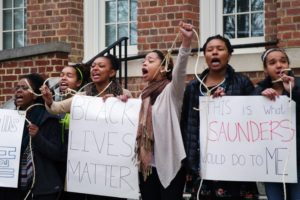
On May 28, 2015, the Board of Trustees at the University of North Carolina (UNC) at Chapel Hill voted to rename Saunders Hall—the building in which the Geography Department is located—following months of student protest that garnered national attention. Nearly a century ago, this building was named in honor of William L. Saunders (1835—1891), a white supremacist who played a leading role in the Ku Klux Klan of North Carolina during the nineteenth century. When the name was bestowed in 1920, the university’s Board of Trustees listed Saunders’ leadership in the KKK as one of his accomplishments deserving recognition. Naming a building for Saunders was therefore a clear attempt to inscribe the legacy of white supremacy into the very fabric of the university’s cultural landscape. And the fact that the building’s name endured for over 90 years speaks to how legacies of anti-black racism are a largely unquestioned and taken-for-granted aspect of our everyday surroundings, both on and off university campuses. We say “largely” because the power of every racialized landscape never goes completely unchallenged, and Saunders Hall was no exception.
Over the years, students led various efforts to have this building renamed, particularly during the anti-apartheid struggles of the 1980s and early 1990s. For example, 25 years ago, students published an op-ed about Saunders’ legacy in the independent student newspaper at UNC, declaring: “Building should not be named for former KKK grand dragon” (Robinson and Hafer in Daily Tar Heel, 1990). These calls to rename Saunders Hall encountered institutional resistance and were largely ignored by university administrators (Chapman, 2006; Babatunde, 2015).
When resistance to renaming places is articulated, it usually takes the form of an argument that the act of renaming will “erase history”—an argument that surfaced, in recent debates over renaming Saunders Hall, among some progressive as well as conservative voices. Yet a distinction must certainly be drawn between acknowledging the past and bestowing honor upon a historical figure through commemoration. The naming of university buildings after individuals is, without question, a case of the latter. As UNC’s Policy on Naming University Facilities and Units states, “[t]he act of naming a University facility or unit for a person … is the conferral by the University of a high and conspicuous honor.” Maintaining a building named in Saunders’ honor, particularly in the face of anti-racist calls to remove it, thus signified the university’s ongoing commitment to honoring the legacy of white supremacy on campus.
Even in 2015, the campaign to rename Saunders Hall was hard fought and proponents, who included geography faculty and students among others, faced considerable opposition. The student activist group, The Real Silent Sam Coalition, held protests on campus and via social media that galvanized national media coverage, drawing on a creative array of tactics—from performance art, the spoken word, poetry, a capella singing, artwork, t-shirts, banners, a manifesto, and the #KickOutTheKKK hashtag to the dramatic reenactment of racist speech from a 1913 Confederate memorialization on campus. The coalition also reproduced a document from the university archives, and regularly posted it around the building all spring, illustrating that the building had not been named despite William Saunders’ role in the KKK, but in fact because of it. Saunders’ position as “Head of the Ku Klux Klan of North Carolina” was indeed acknowledged in Board of Trustees’ proceedings in 1920 as one of his positive contributions, listed only after his status as a Confederate officer, and above his positions as Secretary of State, Treasurer, and Compiler and Editor of the Colonial Records of North Carolina. While the latter position has been the one most frequently identified by the university in recent years as the main reason for naming Saunders Hall, which then housed the History Department, it is evident that much more was at play in naming the building after Saunders as “one of the master minds of North Carolina,” amounting to a kind of victory lap for supporters of the KKK in the state and the university. Shedding light on this history of white supremacy in the campus landscape, the protests garnered support for change among UNC students, staff, and faculty, along with opposition, compelling the Board of Trustees to respond.
In May 2015, the Board of Trustees eventually approved the removal of Saunders’ name from the Hall in a 10-3 vote, but they also passed a 16-year moratorium on any further campus name changes and chose the generic and booster-laden name of “Carolina Hall” to replace that of Saunders, reflecting deep anxieties over the conservation of the university’s signature landscape at a moment of rapid cultural change. The renaming of Saunders Hall is an important achievement but in some ways remains a low bar to set for the naming of university buildings; that is, for students to take classes in a building that is not named for a KKK leader from a brutal period of racial terror in central North Carolina.
Student activists had demanded—and continue to demand—that the building carry the name “Hurston Hall,” to memorialize African American writer Zora Neale Hurston and challenge UNC’s gendered politics, as well as its racialized politics, of public memory (The Real Silent Sam Coalition, 2015). During the 1930s, Hurston was the first black student to attend UNC when she studied with Pulitzer Prize-winning playwright Paul Green. Since African Americans were not allowed to enroll during the Jim Crow era, there is no official record of Hurston’s attendance. UNC’s Board of Trustees used this fact to avoid consideration of Hurston’s name despite strong and vocal student support. Seventy-five years ago, when courts forced the university to desegregate (at least on a token basis), it was African American men who were first enrolled, revealing the complex entanglements of racism and sexism in the campus’ lived history. Even today there are only 16 buildings named for women at UNC, with the vast majority of cases being those of women who were part of a joint naming with their husbands. Only 8 UNC buildings are named for African Americans, and women of color are remembered in the monikers of a mere 4 campus buildings (or 2.5% of the total).
Importantly, the Real Silent Sam Coalition’s struggle in Chapel Hill is part of a growing movement to reconsider why college buildings are named after white supremacists (Svokos, 2015). Such debates are particularly active at schools in the South, such as Clemson, Duke, East Carolina, Radford, and Winthrop, yet similar efforts have arisen across the border in Canada as well. In British Columbia, for instance, students at the University of Victoria unsuccessfully lobbied to rename Joseph Trutch Residence Hall in 2010, which honors a politician known for dramatically reducing First Nations reserve lands in the province. One key challenge for activists is that momentum behind student-led movements is hard to sustain from one cohort of students to the next, a fact university administrators use to their advantage by simply waiting for collective amnesia to sink in again once a vocal group of students graduates. In such cases, faculty can help sustain the memory of past struggles by sharing the history and tactics of social movements with each incoming cohort of university students.
As the situation in Chapel Hill illustrates, geographers are especially well-equipped to play a leading role in social justice struggles over the production of commemorative landscapes on college campuses and beyond. In particular, the discipline of geography has much to offer to understanding and intervening within debates over the politics of place by challenging institutional authorities and university communities to reassess the meanings, values, and identities inscribed into campus geographies through place naming and other forms of commemoration. Even after name changes are made, the need among students for understanding both the contemporary and historical contexts of symbolic practices of naming are no less acute; perhaps more so, as the case of the newly dubbed Carolina Hall suggests.
While some of the most provocative ideas about anti-racism and social change originate at universities, academic geographers could surely do much more to challenge the complicity of their own campus landscapes in perpetuating racism and sexism. With this mind, we call on our fellow geographers at other universities to begin conducting close and critical readings of their own university campuses, engaging the student body and broader public in challenging the legacy of white supremacy that has been etched into the names of buildings, streets, stadia, and parks that collectively form the commemorative landscapes of higher education in America.
Reuben Rose-Redwood, University of Victoria
Derek Alderman, University of Tennessee at Knoxville
Altha Cravey, University of North Carolina at Chapel Hill
Scott Kirsch, University of North Carolina at Chapel Hill
Omololu Refilwe Babatunde, University of North Carolina at Chapel Hill
Josh Inwood, University of Tennessee at Knoxville
References
Babatunde, Omololu Refilwe (2015), Black Liberatory Senses of Place: Creating from Abject Otherness, undergraduate honors thesis, Department of Geography, University of North Carolina, Chapel Hill, NC.
Chapman, John (2006), Black Freedom and the University of North Carolina, 1793-1960, doctoral dissertation, Department of History, University of North Carolina, Chapel Hill, NC, <https://cdr.lib.unc.edu/indexablecontent/uuid:9797fe2f-6cb9-4e40-8674-619fa3a597b4>, last accessed on June 16, 2015.
Robinson, Keith and Claire Hafer (1990), “Building Should Not Be Named for Former KKK Grand Dragon,” The Daily Tar Heel, November 12, p. 11.
Svokos, Alexandra (2015), “Why Are College Buildings Still Named After White Supremacists?” Huffington Post, June 11, <https://www.huffingtonpost.com/2015/06/11/college-buildings-white-supremacists_n_7554958.html>, last accessed on June 16, 2015.
The Real Silent Sam Coalition (2015), “The Real Silent Sam Coalition: Manifesto 2015,” The Siren: Online Magazine, April 6, <https://uncsiren.com/real-silent-sam-coalition-manifesto-spring-2015>, last accessed on June 16, 2015.
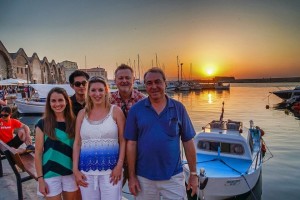
Five members of the AAG were invited speakers of the 5th International Hurricane and Climate Change Summit held in Chania, Greece June 9-14. Co-organised by Climate Specialty Group Chair, Jennifer Collins, the following AAG members presented on topics such as paleo-tempestology, hurricane intensities and tropical cyclone risk assessments: Kelsey Ellis, Harry Williams, Jennifer Collins, Mark Welford and Jerry Jien.
Over the past several years the topic of hurricanes and climate change has received considerable attention by scientists, the insurance industry, and the media. The summit brought together leading academics and researchers on various sides of the debate and from all over the world to discuss new research and express opinions about what is happening and what might happen in the future with regard to regional and global hurricane (tropical cyclone) activity. The goals of the summit were to address what research is needed to advance the science of hurricane climate and to provide a venue for encouraging a lively, spirited, and sustained exchange of ideas. Thus leading scientists from around the world presented their latest research and participated in discussions on this topic.
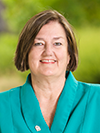
Dr. Jenny Zorn will join CSU Bakersfield on July 31, 2015 as provost and vice president for academic affairs, succeeding Dr. Soraya Coley, who was named president of Cal Poly Pomona last fall. As the chief academic officer, Zorn will oversee the academic enterprise of the University, including the four schools, Extended University, Antelope Valley Center, and academic support services such as enrollment management, grants, research, and faculty affairs. Zorn currently serves as interim provost and vice president for academic affairs at Humboldt State University, prior to which she was the associate provost for academic and international programs at CSU San Bernardino.
Zorn has been an AAG member since 1982 and served on the National Council. Her 26-year career within the CSU system includes serving as associate provost for academic programs, associate and assistant dean in the College of Social and Behavioral Sciences, and professor of geography at CSU San Bernardino.
Zorn holds a bachelor’s degree from Flagler College in St. Augustine, Florida, and a master’s and Ph.D. in geography from The Ohio State University.
Editor’s Note: The Fall deadline for submission of full Doctoral Dissertation Research Improvement (DDRI) proposals to the Geography and Spatial Sciences (GSS) Program is the second Thursday in August each year (August 13, 2015). Learn more.
1) Construct a narrowly focused case study of process in a small community in a faraway land, emphasizing its uniqueness. The case will be of interest to a few others who work in the same area.
An acronym has been developed for these projects, “WISC” (Wallowing in a Specific Case). The GSS program and NSF in general does not prioritize support for WISCy proposals as it needs to support research that generates new knowledge more broadly and with relevance to US society.
2) Provide a clear statement about what the proposal is about only deep within the Project Description because the background is really important and the objective of the study can’t be understood until that background is provided.
Realize that many DDRI reviewers are reading 12-18 proposals and are often reading proposals late at night. You need to grab them right away, in the opening paragraph, to tell them what the project is about and why it is important. Then you can provide the background and literature review before focusing in on methods and data analysis.
3) Write a jargon-filled dense proposal, steeped in the latest theory from your most recent graduate seminar that is only understandable to the few people out there who are within your narrow subfield.
Review panels consist of well-rounded geographers and spatial scientists some of whom may be from your narrow area well. NSF does its best to have your proposal be reviewed by people who know your area; however the reality is that most reviewers will more likely not be directly from your subfield. This makes it really important that you write a proposal that is readable to a broad audience as well as attending to adequate detail for experts. In order to prepare for this, share drafts with people from both within and outside your subfield so ensure comprehension.
4) Provide an excessively long list of research questions and/or sub-questions or hypotheses to be tested just to be sure you are covering all bases.
It is best to focus on a limited and tight set of research questions or hypotheses. This, especially when tightly integrated with methods and analysis, provides reviewers with much greater confidence that the project is feasible.
5) Take the “everything including the kitchen-sink” approach to methods to be used without any indication of how the various strands of data will be integrated or how all that data will be analyzed in order to answer research questions.
The selection of methods needs to be carefully thought-through as to how and why those are the best methods to answer the stated research questions or test the posed hypotheses. Justify your chosen methods and provide citations for them.
6) Spend only a paragraph or two on data analysis and declare that your data analysis will consist of entering field notes into NVivo or that you will perform some statistical analysis.
Most proposals are declined because insufficient information is provided on data analysis. Many proposals spend a lot of space on literature review, theoretical framing, and, sometimes, on methods, but much too little on analysis. Don’t do this. Competitive proposals develop a comprehensive data analysis plan in which statistical analyses are specified and details provided on coding mechanisms to be used in NVivo or other software package. Also be sure to tie the data analysis back to your research questions or hypotheses.
7) Include language specific to Intellectual Merit and Broader Impacts in the Project Summary but then not discuss Intellectual Merit and Broader Impacts in the Project Description.
Note that Intellectual Merit and Broader Impacts are the basis of review criteria at NSF and these are the aspects that reviewers/panelists are asked to evaluate your work by. Become familiar with what NSF means by these and address how your proposal addresses both these in the project description as well as the summary.
8) Ignore Broader Impacts, especially in the way that NSF sees these.
Your advisor might have said “don’t bother with Broader Impacts, they don’t matter” and that might have been the case in the past, however, this has changed a lot, and you need to read carefully about what is meant by Broader Impacts, and think creatively about how your research might contribute to society. Recall that NSF is a US taxpayer funded federal agency and is overseen by Congress; therefore, where possible, find a way to highlight how your research and findings might have some impact on or relevance to US society. It does not mean that you have to do this in the project, but you need to think of how the new knowledge generated in your project could be used to benefit society.
9) If submitting a proposal for the second time, don’t pay any attention to suggestions that reviewers made because it is clear that the reviewers simply didn’t understand your fabulous project.
Even though a resubmitted proposal is treated as a new proposal, some reviewers who read it before will read it again and remember, and might note that you did not respond to suggestions from the last time. Realize that reviewers provide feedback to let you craft a stronger proposal. Despite this, for GSS it is generally best to avoid including a statement explaining what you did, just do it, and use the space for more important information.
10) Include a sloppy, incomplete, poorly, and inconsistently formatted References Cited section figuring that reviewers don’t look at it.
Many reviewers turn first to the references cited section to know, at a glance, what the literature is that you are drawing from. Also, it simply does not look good if you have left out key references, or if these are referenced poorly. Attention to the detail of an accurate References Cited section reflects well on your ability to be attentive to detail, which helps assure reviewers that you are capable of executing the project.
11) Ignore your own positionality in research in which this might affect access to certain populations and how it might impact the research process itself.
It is important to note this if relevant. Reviewers need to assess the viability of your project and this is a component that might affect that.
12) Declare that your project is the first ever to research what it is you are doing.
You may believe so given your literature review that is mostly internet-based, however buried somewhere in a dusty library might be something similar. It is best to emphasize what is new and fresh about your work, not that it is the first ever.
13) Include a cute title that tells you little about what the proposal is about and is better used for a presentation or manuscript title.
You might be surprised at how many decisions about your proposal are made that rely only on the title. It is best to use a clear declarative title.
14) Provide poorly rendered maps and figures that are so small that that they are illegible.
Many maps included in proposals are quickly generated using a GIS and are almost meaningless. You are submitting to the Geography and Spatial Sciences Program, so consider proper cartographic conventions and design. Only include legible figures and only if they add to the narrative.
15) Use the smallest and densest font available, and leave no spare lines of white spaces in order to cram as many words and sentences into the 10 pages of the project description.
Do pay attention to the look and flow of the proposal; ‘style’ matters. You want to draw the reviewer’s eyes to the key points, without cluttering their view with too much bold and underlining. Definitely include spaces between sections so that you proposal breathes. Recall that reviewers are often reading these late at night when they are tired and you don’t want to irritate them by making the reading hard.
16) Provide a Data Management Plan (DMP) that does not follow the current NSF format and does not indicate clear plans for long-term data access and archiving plans using institutional data repositories.
DMPs are a relatively newer additional to the proposal and many advisors remain unaware of their importance and the need to comply with the format. Publicly funded research, such as that by NSF, needs to have data generated with its funds to be made available to the public (that which is not projected under IRB). Careful attention to this demonstrates that you are careful with details and follow directions. Note – keeping data on a “secure hard-drive” and stating that “data will be made available upon request from the co-PI” are no longer adequate. Inquire with your institution as to what they have available for long term data storage and curation.
17) Use a hypotheses-testing research design when a research question approach is more than adequate.
Do not force your research into a hypothesis-testing format if this is not necessary for your research design. Much research funded by NSF does not involve testing hypotheses, but you do need to clearly construct a set of research questions and then provide clear methods and data analysis to answer these.
18) Propose doing research in a country in which you will need to speak another language and have no evidence of having learned that language or propose no plans (or budget) for the use of translators.
Preparation for fieldwork needs to be demonstrated via preliminary or other means. Do not be afraid to discuss how you have achieved cultural competency to work in a foreign place. This provides reviewers with assurance that the project is viable. If you need to use translators, be sure to budget for these and address the challenges of the need to work with them.
19) Use whatever indirect rate your institution’s Sponsored Research Office (SPO) tells you must be used.
If your proposed research is to be conducted away from the main location of your university, be sure to inquire if there is an “off-campus” indirect rate that can be applied to your proposal’s budget. This rate is usually lower and would provide more money for the actual research. Busy budget people sometimes forget to consider this.
20) Use language such as “I will explore the such and so in place xyz.”
The verb “to explore” comes across as too preliminary for some reviewers. For NSF better verbs to use are action verbs such as “to analyze” or “to investigate.”
21) Avoid dealing with alternative scenarios regarding the viability of your data collection plans.
Many DDRI applicants are doing research in foreign places with groups and individuals that may or may not be open and accessible to planned data collection when it is actually tried. Outlining a Plan B, i.e. alternative ways of accessing data you need in order to answer you research questions, shows that you have really thought through your research design and have tempered your plans with a dose of realism.
22) Rely on your advisor for all answers to your technical questions about NSF GSS proposal submission.
Advisors may know the answers, but many things change at NSF, including due dates and necessary parts to proposals. Do not rely on old habits that may no longer be current practice. Be sure to read carefully through the website and the solicitation for GSS DDRI proposals yourself. Also do not hesitate to contact the program officers; they can answer any questions you might have. Use this handy email address, gss-info [at] nsf [dot] gov.
— Antoinette WinklerPrins
Johns Hopkins University
antoinette [at] jhu [dot] edu
The opinions expressed in this document are those of a former Geography and Spatial Sciences Program Director at NSF who is not working at the agency at the time of writing. Any opinion, finding, conclusions, or recommendations expressed in this material are those of the author and do not necessarily reflect the views of the National Science Foundation (U.S.A.).
PRESIDENT’S COLUMN
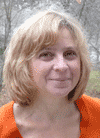
By Mona Domosh
Many of us teach courses that are shaped by anti-colonial and antiracist scholarship. We include readings and topics in our classes that provide our students with frameworks for better understanding issues of inequality. We have compelling ‘how-to’ stories of what it means to incorporate race, ethnicity and anti-colonial perspectives into our classrooms.[1] We have monographs, edited collections, special issues, and a lengthy list of pertinent journal articles that explicitly and implicitly interrogate the social construction of race, black geographies, and anti-colonial struggles.[2] But I would argue that still, with all of this, for the most part, we are writing, teaching, and recreating white geographies: by ‘we’ I mean almost all of us (including me); by ‘white’ I mean ways of seeing, understanding, and interrogating the world that are based on racialized and colonial assumptions that are unremarked, normalized, and perpetuated. Continue Reading.
Recent columns from the President
 Registration for the AAG Annual Meeting in San Francisco opens on July 31, 2015. AAG will also begin accepting abstracts and proposals for presentations. The 2016 conference will take place March 29-April 2. Researchers, scholars, professionals, and students are welcome to present papers, posters, and panel discussions on all topics relevant to geography. Abstracts are due by Oct. 29, 2015, but may be edited through February 18, 2016.
Registration for the AAG Annual Meeting in San Francisco opens on July 31, 2015. AAG will also begin accepting abstracts and proposals for presentations. The 2016 conference will take place March 29-April 2. Researchers, scholars, professionals, and students are welcome to present papers, posters, and panel discussions on all topics relevant to geography. Abstracts are due by Oct. 29, 2015, but may be edited through February 18, 2016.
NEWS
Each month, AAG will feature one of its GeoMentors volunteers who help schools and teachers introduce GIS and associated geographic concepts into classrooms across the country. The GeoMentors program is a joint effort by Esri and the AAG to develop a nationwide network of volunteers to support the U.S. Department of Education’s ConnectED Program, for which Esri has agreed to donate free GIS software to all K-12 schools in the U.S. In this inaugural entry, AAG spotlights Paisly Di Bianca, an Environmental Protection Specialist/GIS Coordinator with the US EPA. Learn More.
FUNDING OPPORTUNITIES
The National Institutes of Health (NIH) has issued a funding opportunity announcement (FOA) focused on sexual and gender minority (SGM) populations, including lesbian, gay, bisexual, transgender, and intersex populations. Participating institutes and offices include: Cancer, Alcohol Abuse and Alcoholism, Allergy and Infectious Diseases, Deafness and other Communication Disorders, Dental and Craniofacial, Mental Health, Minority Health and Health Disparities, and the Office of Behavioral and Social Science Research. Read More.
The National Institute of Minority Health and Health Disparities (NIMHD) within NIH has released a funding opportunity announcement (FOA), Advancing Health Disparities Interventions Through Community-Based Participatory Research (RFA-MD-15-010), seeking applications designed to support promising community interventions using community-based participatory research (CBPR) principles and approaches aimed at reducing and eventually eliminating health disparities. The FOA follows a 2012-issued FOA, NIMHD Community-Based Participatory Research (CBPR) Initiative in Reducing and Eliminating Health Disparities: Planning Phase, (RFA-MD- 12-006). Read More.
The National Institute of Minority Health and Health Disparities (NIMHD) has issued a funding opportunity announcement, Building Population Health Research Capacity in the U.S. Affiliated Pacific Islands (RFA-MD-15-011), designed to (1) build capacity of organizations in the USAPI to conduct population health research, and (2) support population health research projects that will provide novel data for the United States-Affiliated Pacific Islands (USAPI) populations and serve as the foundation for future research efforts. Read More.
The Geography Education National Implementation Project (GENIP) Coordinating Committee seeks proposals from non-profits, educational institutions, or individuals to conduct guided research on the status of K-12 geography education in the US and report findings to the committee. GENIP is offering to fund up to $12,000 for research work to collect data and submit it to an online committee resource. Funding is for a 12 month period with the potential to renew for a second year of funding and research. This is an excellent opportunity to work closely with the GENIP Coordinating Committee which represents the four national geography organizations.
Proposals should be submitted by June 10, 2015. Learn More.
MEMBER & DEPARTMENT NEWS
Anne Kelly Knowles (Geography Department, Middlebury College) has been awarded a fellowship from the Guggenheim Foundation for a project titled Telling the Spatial Story of the Holocaust. This project grew from her ongoing work with the Holocaust Geographies Collaborative, an international group of geographers and historians exploring the geographical dimensions of the Holocaust with spatial methods, notably GIS (geographic information systems). Read More.
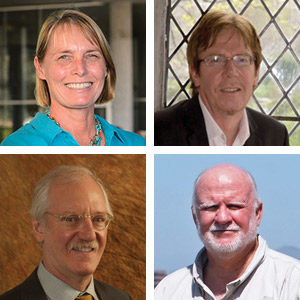 Janet Franklin inducted into National Academy of Science; joins the other NAS members at Arizona State University
Janet Franklin inducted into National Academy of Science; joins the other NAS members at Arizona State UniversityApril 25, 2015 saw the induction of Janet Franklin, professor of geography at Arizona State University, into the National Academy of Sciences, following her election in April 2014. This was a memorable week for Dr. Franklin, who two days later was informed that she had been named a Fellow of the Ecological Society of America. The title of Fellow is given to a select number of ESA members each year to honor those who are recognized by their peers as distinguished for their contributions to the discipline.
As a member of the National Academy of Sciences, Janet Franklin joins three other ASU geographers: Luc Anselin, B.L. Turner II, and Stewart Fotheringham. Read More.
Daniel A. Griffith, Asbhel Smith Professor of Geospatial Information Sciences at the University of Texas/Dallas, was elected a fellow of the American Statistical Association (ASA), the preeminent professional statistical society in the United States, in recognition of his reputation in and outstanding contributions to the field of statistical science. His citation by the ASA reads: for influential contributions to the theory and practice of spatial statistical analysis and the effective dissemination and popularization of these methods in geography and environmental science through research, teaching, and editorial endeavors. Read More.
IN MEMORIAM
PUBLICATIONS
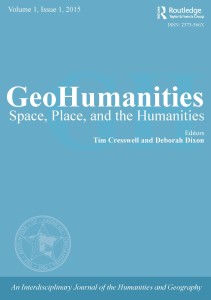 AAG Seeks Papers for New “GeoHumanties” Journal
AAG Seeks Papers for New “GeoHumanties” JournalGeoHumanities is a new journal being launched by the Association of American Geographers and will be published by Taylor and Francis. GeoHumanities publishes original peer-reviewed articles that span conceptual and methodological debates in geography and the humanities; critical reflections on analog and digital artistic productions; and new scholarly interactions occurring at the intersections of geography and multiple humanities disciplines. GeoHumanities includes full-length scholarly articles its Articles section, and shorter creative pieces that cross over between the academy and creative practice in the Practices and Curations section. GeoHumanities is seeking papers in both of these sections. Learn More.
The Annals of the Association of American Geographers invites abstracts of papers to be considered for a special issue on Mountains. This will be the ninth of a series of annual special issues that highlight the work of geographers around a significant global theme. Papers are sought from a broad spectrum of scholars who address social, cultural, political, environmental, physical, economic, theoretical, and methodological issues focused on the mountains. These could include original research in such areas as mountains as sites and corridors of cultural and environmental diversity and gradients, mountains as the “water towers of the world”, mountain as regions highly sensitive to climate change, the critical nature of mountain regions as borders and as regions of conflict, mountain regions as barriers to migration yet also home to large numbers of refugees, mountains as sources of hazards and risk, mountains as sites of sacred importance, and as destinations for tourism and as cultural icons. Abstracts of no more than 250 words should be submitted by June 15, 201500. Read More.
The Geography Education National Implementation Project (GENIP) has received a request from The College Board for a proposal to develop a new Advanced Placement course in Geographic Information Science and Technology (GIS&T). The AAG will lead a course proposal development team on behalf of GENIP.
To apply for consideration as a proposal author and/or reviewer, please submit a short (250-word maximum) statement of interest and a current resume/CV to Dr. Michael Solem, AAG Director of Educational Research and Programs, at msolem [at] aag [dot] org by June 15, 2015. Proposal authors and reviewers will receive a stipend to support their work. Read More.
The current status of learning progressions research in the U.S. was the focus of a recent GeoProgressions panel and workshop at the AAG Annual Meeting in Chicago. Those sessions revealed for the participants that a “learning progression” in education and educational research can take many forms, as can the ways learning progressions have been applied with students in school classrooms. The picture becomes even more complex when viewed from the perspectives of educators in different parts of world.
Sensing an opportunity to learn from the experience of a more diverse community of geographers and educational researchers, the GeoProgressions project aims to produce an edited volume exploring the concept of learning progressions in the context of curriculum development, teaching and assessment practices in different countries.
Application materials from prospective authors are due on June 30, 2015. Learn More.
MORE HEADLINES
Apply by June 15
The Association of American Geographers has been granted Observer Organization status to the UN Framework Convention on Climate Change. With this formal designation, the AAG is permitted to submit to the UNFCCC Secretariat its nominations for representatives to attend the United Nations Climate Change Conference that will take place from November 30 – December 11, 2015 on the outskirts of Paris in Le Bourget, France (COP-21/CMP11). Learn More.
EVENTS CALENDER
Submit News to the AAG Newsletter. To share your news, submit announcements to newsletter [at] aag [dot] org.
The United States-Affiliated Pacific Islands (USAPI) consist of the U.S. territories of American Samoa, Guam, the Commonwealth of the Northern Mariana Islands, the Federated States of Micronesia, Republic of the Marshall Islands, and Republic of Palau. The U.S. is responsible for the essential operations, health, education, and defense for these jurisdictions. The residents of these jurisdictions are considered to be a U.S. health disparity population. The National Institutes of Health (NIH), however, acknowledges that this geographic region has received very little NIH support to conduct health and health disparities research.
According to NIH, there is a “critical” need to collect basic epidemiological and health services data for populations residing in USAPI. In many available studies of datasets, data for USAPI populations are aggregated with data for Native Hawaiians or Asians Americans. There is further recognition that the research infrastructure for local organizations, including universities, departments of public health, healthcare organizations, or health-focused community organizations, which are likely to be best positioned to collect such information, may not be sufficiently developed to conduct large-scale population health research.
To this end, the National Institute of Minority Health and Health Disparities (NIMHD) has issued a funding opportunity announcement, Building Population Health Research Capacity in the U.S. Affiliated Pacific Islands (RFA-MD-15-011), designed to (1) build capacity of organizations in the USAPI to conduct population health research, and (2) support population health research projects that will provide novel data for USAPI populations and serve as the foundation for future research efforts.
Potential research topic areas may include: help-seeking patterns and barriers regarding formal healthcare as well as integrative or indigenous medicine, community-level needs that are not adequately addressed by existing community-based preventive or health promotion interventions; type, intensity, and quality of healthcare received; and the incidence/prevalence of infectious and non-communicable chronic disease and of risk factors for these conditions.
Courtesy COSSA Washington Update